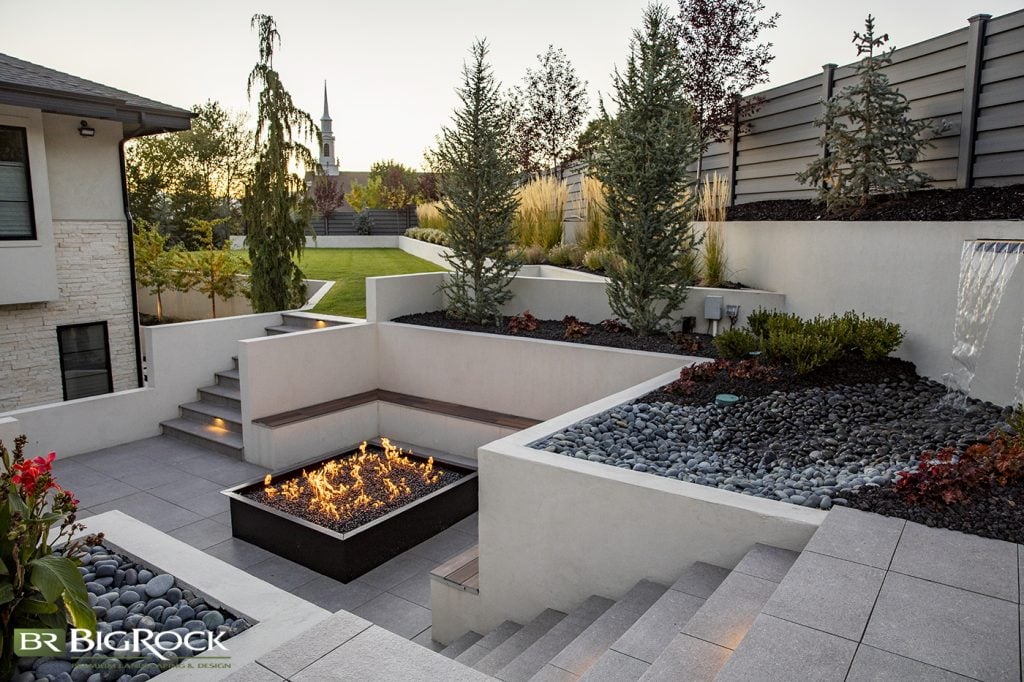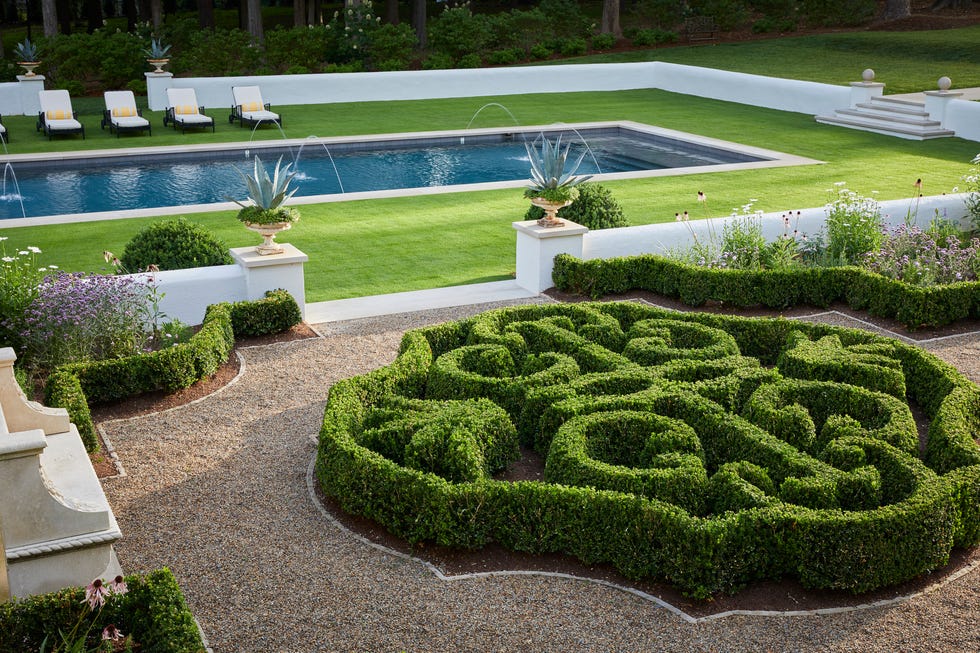Eco-Friendly Landscaping Trends Featuring Artificial Grass for Water Savings
Change Your Yard With Ingenious Landscape Design Strategies and ideas
Transforming a yard needs thoughtful factor to consider of its special qualities. Reliable landscape Design can improve both functionality and aesthetic charm. By exploring numerous techniques, one can develop an area that not only shows individual design but additionally sustains regional biodiversity. As the trip unfolds, questions regarding plant sustainability, format, and option arise, motivating a much deeper expedition into exactly how to make these ideas come to life.
Analyzing Your Outdoor Area: Comprehending Your Garden's Possible
Reviewing outside room is vital for effective landscape layout. Understanding the special features of a yard permits designers to maximize its possibility. Factors such as dirt high quality, sunlight exposure, and existing frameworks play a crucial function in identifying what can be attained. Evaluating the topography assists recognize areas for growing, paths, or water functions, while keeping in mind drainage patterns ensures that plants grow without waterlogging.
Acknowledging the yard's microclimates can affect plant option and positioning. Observing exactly how the area is made use of by homeowners informs functional Design options, such as seating locations or play zones. Additionally, thinking about the bordering atmosphere and neighboring landscapes can provide inspiration and context for Design choices. By completely examining these components, one can create a cohesive and welcoming exterior room that mirrors the proprietor's vision while integrating with nature. Ultimately, a thorough examination prepares for an effective landscape Design job.
Picking the Right Plant Kingdoms: An Overview to Color, Appearance, and Seasonal Interest
When choosing plants for a landscape design, comprehending the interplay of color, structure, and seasonal rate of interest is crucial for creating a vivid and vibrant garden. Shade can evoke feelings and set the tone for the area; subsequently, selecting an unified palette enhances visual appeal. Warm tones like oranges and reds create power, while cooler tones like blues and environment-friendlies offer tranquility.
Appearance adds depth and dimension, enabling a mix of vegetation sizes and shapes. Integrating fine-textured plants with bold-leaved ranges creates comparison and intrigue.
Seasonal interest is necessary for keeping year-round appeal. Selecting a variety of plants that bloom in different seasons guarantees that the yard continues to be lively, shifting from springtime's lively blossoms to fall's rich vegetation. By attentively considering these elements, one can curate a landscape that is not only cosmetically pleasing yet additionally varied and engaging throughout the year.

Creating Practical Zones: Creating Spaces for Leisure and Enjoyment
Creating useful areas in a landscape Design improves the usability of outdoor rooms, allowing property owners to effortlessly blend leisure and amusement. By attentively dividing areas right into unique zones, people can deal with various activities, from quiet retreats to dynamic celebrations. A properly designed space might incorporate a comfortable reading nook nestled amongst lavish plant, providing a peaceful escape (Landscaping Contractor). On the other hand, a vivid exterior eating area can act as the excellent setup for parties with friends and family
Purposefully placed paths can direct visitors in between these zones, making sure very easy navigating. Additionally, including components like seating areas, fire pits, or water attributes can boost the total setting and performance. The assimilation of varied appearances and shades in each area can produce visual rate of interest while preserving a cohesive visual. Eventually, making functional areas allows house owners to maximize their outside experience, changing their gardens into versatile spaces that satisfy diverse way of living demands.
Integrating Hardscape Aspects: Patios, Walkways, and Focal Information
Including hardscape elements into landscape Design enhances useful areas by providing framework and aesthetic appeal. Patios act as essential exterior space, allowing property owners to take pleasure in dishes and celebrations in a defined area while boosting access. The selection of materials, such as all-natural rock or concrete, can significantly affect the overall visual, mixing flawlessly with the surrounding environment.
Pathways facilitate motion with the garden, assisting site visitors while adding deepness and interest. These courses can be crafted from different materials, including crushed rock, pavers, or block, each adding to the yard's personality.
Centerpieces, such as attractive rocks, sculptures, or water features, attract the eye and create a feeling of function within the landscape. Purposefully positioned, these elements can change a common yard right into a fascinating room, welcoming exploration and engagement. Via thoughtful assimilation of hardscape, a landscape comes to be not only functional but likewise aesthetically magnificent.
Enhancing Privacy and Security: Natural Obstacles and Frameworks
To enhance privacy and security in landscape style, making use of all-natural barriers such as dense hedges can efficiently protect a building from undesirable sights. Additionally, setting up personal privacy fences offers a strong structure that adds to a feeling of safety and security and privacy. With each other, these elements create a more intimate outside space while preventing prospective breaches.
Planting Dense Hedges
While many house owners seek aesthetic charm in their landscapes, planting thick bushes offers a dual purpose of enhancing personal privacy and safety. These all-natural barriers produce a visual shield, effectively blocking the view from prying eyes and preventing possible intruders. Numerous varieties, such as boxwood, holly, or privet, can be chosen for their development patterns and vegetation density, ensuring lush insurance coverage throughout the year. In addition, properly maintained hedges can contribute to a relaxing setting, absorbing sound and supplying an environment for wildlife. The critical positioning of these hedges can define home borders and develop remote outdoor areas, allowing property owners to enjoy their yards with a feeling of safety. Eventually, dense bushes are a reliable remedy for mixing appeal with performance.
Installing Privacy Fences
Personal privacy fences serve as one more efficient approach for enhancing privacy and safety and security in residential landscapes. These frameworks not just delineate residential or commercial property boundaries but likewise produce a feeling of seclusion, securing house owners from spying eyes. Different products, such as steel, timber, and vinyl, deal distinctive visual appeals and levels of longevity, allowing house owners to pick based upon their Design preferences and maintenance needs.

Sustainable Landscape Design: Eco-Friendly Practices for a Greener Garden
Lasting landscape design highlights the value of indigenous plant choice and water preservation techniques. By choosing plants that are well-adapted to the regional atmosphere, garden enthusiasts can reduce maintenance and resource usage. Executing effective sprinkling approaches further improves the garden's environmental advantages, promoting a healthier ecological community.
Native Plant Selection
Indigenous plant choice plays an important function in sustainable landscaping, advertising biodiversity and decreasing the demand for chemical inputs. By picking plants belonging to a details region, gardeners can develop habitats that support neighborhood wild animals, such as pollinators, birds, and useful pests. These plants are adjusted to the local climate and soil problems, requiring less water and upkeep compared to non-native varieties. Furthermore, native plants can aid manage erosion and improve soil health and wellness, promoting a well balanced community. Integrating native species into landscape develops not just boosts the visual appeal of the garden however also adds to environmental durability. Eventually, indigenous plant choice is a crucial technique for those looking for to cultivate a lively and sustainable garden.
Water Conservation Techniques
Including native plants can considerably boost water conservation efforts in landscaping. These plants are well-adapted to local climates, needing much less water and maintenance than non-native selections. Carrying out drip watering systems permits targeted watering, minimizing evaporation and overflow. Rain collecting systems can additionally be installed, storing and collecting rainwater for yard use. Mulching assists retain dirt dampness, reducing the regularity of watering. Organizing plants with comparable water needs together develops reliable sprinkling zones, even more saving water. Additionally, utilizing permeable materials for paths enables rain to leak right into the ground, replenishing groundwater materials. By using these water preservation methods, gardeners can produce sustainable landscapes that thrive while minimizing environmental impact (Landscape Architect). Such methods add to a greener garden and a healthier ecosystem
Individualizing Your Layout: Including Distinct Features and Personal Touches
Just how can one transform a garden into an individual haven? Customizing a landscape Design involves integrating special functions that reflect individual tastes and lifestyles. One approach is to incorporate customized garden art, such as sculptures or handcrafted birdhouses, which can act as prime focus and discussion beginners. Additionally, customizing plant selections based upon seasonal flowers or personal preferences can produce a vivid and progressing space.
Producing useful areas, such as a comfy reading nook or an exterior dining space, can improve functionality and convenience. Including aspects like a you can try these out fire pit or a water feature can introduce a welcoming ambiance.
Color appearances, schemes, and products should straighten with the home owner's style, whether it be modern, rustic, or eclectic. Ultimately, the objective is to develop an area that reverberates with the person's identification, making the garden not simply an aesthetic joy but a real extension of the house owner's personality.
Frequently Asked Concerns
How Do I Allocate a Landscape Design Project?
To budget plan for a landscape Design project, one should assess project range, study expenses for products and labor, prioritize features, and designate an added 10-20% for unexpected expenditures, making sure a sensible monetary plan.
What Devices Are Important for Home Yard Landscaping?
Necessary tools for home garden landscaping include a shovel, rake, garden fork, pruning shears, trowel, hoe, and wheelbarrow. These tools aid in dirt prep work, growing, maintenance, and efficient transportation of materials throughout the landscape design job.
How Can I Keep My Yard After Redesigning?
To keep a redesigned garden, routine watering, mulching, weeding, and pruning are essential (Landscaping Contractor). Surveillance plant wellness, adjusting soil nutrients, and seasonal plant care add to a thriving environment that showcases the garden's brand-new Design effectively
When Is the Ideal Time to Beginning Landscaping?

Can I DIY My Landscape Design or Should I Employ a Specialist?
People can certainly DIY their landscape Design if they possess creative thinking and standard abilities; however, employing a specialist often guarantees a more cohesive and expert result, specifically for intricate tasks or certain Design ambitions.
Identifying the yard's microclimates can affect plant selection and positioning. When selecting plants for a landscape design, understanding the interplay of color, texture, and seasonal passion is essential for creating a vibrant and lively garden. Selecting a selection of plants that grow in different periods warranties that the garden remains dynamic, moving from spring's vivid blossoms to autumn's abundant foliage. Incorporating indigenous types into landscape designs not just boosts the visual appeal of the garden but likewise contributes to environmental durability. Necessary tools for home yard landscaping consist of a shovel, rake, garden fork, trimming shears, trowel, hoe, and wheelbarrow.